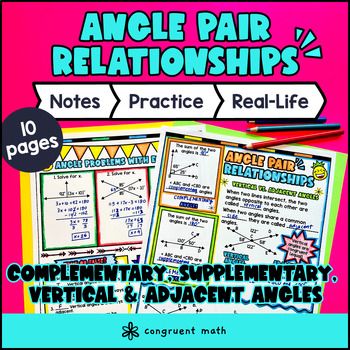Want more ideas and freebies?
Get my free resource library with digital & print activities—plus tips over email.
Join for Free Resources →
$4.25
Ever wondered how to teach angle relationships in an engaging way to your 7th grade students?
In this lesson plan, students will learn about complementary, supplementary, vertical, and adjacent angles and their real-life applications. Through artistic, interactive guided notes, check for understanding, a practice coloring worksheet, and a maze worksheet, students will gain a comprehensive understanding of angle relationships.
The lesson culminates with a real-life example that explores how these angle relationships can be used in practical situations. Students will read and write about real-life uses of these math skills, connecting the concept to the world around them.

$4.25
After this lesson, students will be able to:
Before this lesson, students should be familiar with:
As a hook, ask students why understanding angle relationships is important in real life. Refer to the real-life application page of the resource and the FAQs below for ideas.
Use the first page of the guided notes to introduce angle relationships, specifically complementary, supplementary, vertical, and adjacent angles angles. Walk through the definitions and properties of these angles, emphasizing how to identify and solve for unknown angles. Then, move onto page 2 of the guided notes, where students have to write equations to solve for the unknown angle using the angle pair relationships.
Based on student responses, reteach concepts that students need extra help with. If your class has a wide range of proficiency levels, you can pull out students for reteaching, and have more advanced students begin work on the practice exercises.
Have students practice angle relationships using the practice worksheet problems (page 2 of guided notes). Then, have students work on the maze activity involving angle pair relationships (page 3). Walk around to answer student questions.
Fast finishers can dive into the color-by-number activity (page 4 of guided notes) for extra practice. You can assign it as homework for the remainder of the class.
Bring the class back together, and introduce the concept of real-world application of angle relationships. Explain to the students that understanding angle relationships can be useful in various real-life situations.
For example, architects and engineers need to consider angle relationships when designing buildings and structures. They use angles to determine the stability and strength of the structures they create. By understanding how different angles interact with each other, architects and engineers can ensure that their designs are safe and structurally sound.
Angle relationships are also important in traffic engineering. The last page of the guided notes go through this in detail. Have students read the passage and then reflect on the real life applications of angle pair relationships (page 5 of guided notes).
Refer to the FAQ for more ideas on how to teach real-life applications of angle relationships.
If you're looking for digital practice for angle relationships, try my Pixel Art activities in Google Sheets. Every answer is automatically checked, and correct answers unlock parts of a mystery picture. It's incredibly fun and a powerful tool for differentiation.
Here is one activity to explore:
A fun, no-prep way to practice angle relationships is Doodle Math - they're a fresh take on color by number or color by code. It includes multiple levels of practice, perfect for a review day or sub plan.
Here is one activity to try:
Complementary angles are two angles that add up to 90 degrees.
Supplementary angles are two angles that add up to 180 degrees.
Vertical angles are a pair of opposite angles formed by two intersecting lines or line segments.
Adjacent angles are two angles that share a common vertex and side.
To find the measure of an unknown angle using angle relationships, follow these steps:
Guided notes are a structured way of teaching angle relationships by providing students with a framework to organize and record important information.
There are several ways to engage students during a lesson on angle relationships:
To assess your students' understanding of angle relationships, you can:
Get my free resource library with digital & print activities—plus tips over email.
Join for Free Resources →